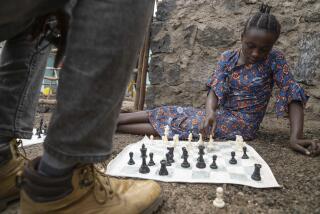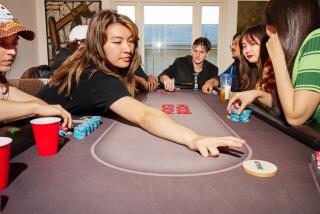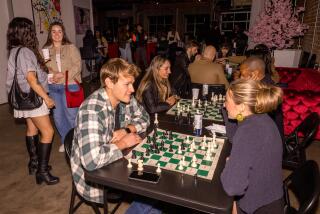Escaping into the realm of Cambodian chess
The Cambodian men gather near a parking lot hunched over chessboards, some contemplating their next move, others squeezed in closely, offering strategy. Some tease opponents or cheer on players.
The ages range wildly from 18 to 70, but all share an obsession with Cambodian chess, which varies subtly from the game commonly played in the U.S.
They come together every day on a sidewalk on the eastern cusp of Long Beach’s Cambodia Town. The smell of tobacco hangs heavy over the group, and a small heap of sunflower seeds sits within spitting distance. The men press together under the shade of a bottle brush tree jutting out of the sidewalk where a Cambodian flag flies alongside an American one. The buzzing of traffic along busy Anaheim Street doesn’t faze them as they shuffle pieces across the board.
It is here in an enclave of refugees and immigrants, many of whom fled the brutality of the Khmer Rouge regime, that an addicting game of lateral and sideways moves brings escape from a dark past.
“It’s part of a healing process,” said Gary Fultheim who owns a building near the pick-up chess competitions. “All the problems that the Third World can put forth, Cambodia had. This is their escape from that. This is their cheap psychiatry.”
The chess players gather religiously each day, whether it’s blazing hot or gray with rain, some watching for hours as their wives or mothers shop at the nearby Phnom Pich pharmacy or other storefronts in the ethnic district. At night the green and white plastic chairs are stacked and chained to a light post, and the homemade chessboards are stashed in bushes along with chess pieces.
Kosal Kom, 49, has a small dental practice in the United Cambodian Community Center shopping plaza that borders the area where the chess players gather. By mid-afternoon Kom often joins the 20 or so men to play a game or two with his friends. Sometimes, his friends say, he steps out in between patients to watch the matches.
“It’s very addicting,” Kom said. “Even the people that just watch, they stay for hours.”
For 18 years — since his practice in the immigrant community first opened — Kom has watched as men gathered, sometimes playing until midnight. For a while, the competitions took place inside the building where Kom’s offices are, but then tougher smoking laws forced them outdoors.
The level of devotion to the game goes beyond the competition. The boards are all handmade, and often so are the game pieces.
On several of the 42 trips Fultheim has taken to Cambodia, he has returned with hand-carved chessmen for the players who gather outside the Anaheim Street building.
The differences between Cambodian chess and the more familiar version of the game are slight, though significant enough that it would throw off someone unfamiliar with the rules.
In Cambodian chess, for instance, pawns stop when they reach the third line from an opponent’s side, but from there they can move diagonally backward and forward.
The queen’s role is different too. Shaped like a small spinning top, the neang, or “young lady,” serves as a slightly more potent pawn that can slide sideways and back and forth one space at a time, but lacks the powers given the queen who reigns over the board in common chess, galloping multiple spaces at a time.
Other pieces used in Cambodian chess include the touk, or boat, which serves a similar role as the rook, and the trey, or fish, which are the pawns.
The Cambodian version of the game was brought to America during several waves of immigration, the largest swell arriving when the U.S.- sponsored government in Cambodia fell and the Khmer Rouge took power. There are now about 20,000 Cambodians living in Long Beach — the second largest Asian population in the city after Filipinos.
According to a study performed by the U.S. Census Bureau, the influx of Cambodians to the city can be traced to the 1950s, when what is now Cal State Long Beach had an exchange program with the country.
When the Khmer Rouge came to power in 1975, there was already a largely well-educated Cambodian community in Long Beach to greet and support the refugees. Many came to Long Beach because of the Buddhist temples, social agencies and large Khmer-speaking population, the census study said.
Frank You, 59, who creates Khmer subtitles for Thai movies, arrived 12 years ago and for the last decade has been one of the regulars at the chess games.
While the gathering of men is largely informal, a small association has been created to host an annual chess competition, which has drawn players from Florida, Massachusetts and Washington state. One year, a player from France showed up for the two-day chess showdown.
Asked if his wife minds that he sometimes stays out to play a board game deep into the evening, You said it’s a better vice than gambling or drinking.
“My wife is happy to let me play,” he said. “We don’t use our money, and we have a lot of fun.”
More to Read
Sign up for Essential California
The most important California stories and recommendations in your inbox every morning.
You may occasionally receive promotional content from the Los Angeles Times.









